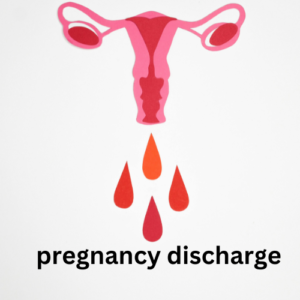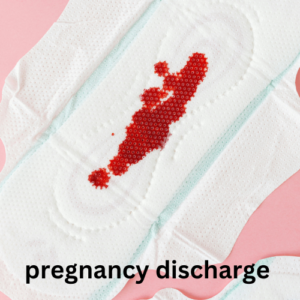Pregnancy discharge- cause, types, myths & tips
Pregnancy is a journey of physical and emotional changes. Among these changes, pregnancy discharge is a common but often misunderstood topic. For many women, there are questions and concerns about this discharge. So today we will know what is pregnancy discharge, its causes, types, myths and when to seek medical advice-
What is Pregnancy Discharge?
Pregnancy discharge refers to vaginal discharge that increases in quantity during pregnancy. Medically called leucorrhoea, this discharge is usually thin, milky white and mildly smelling. It plays an important role in maintaining vaginal health by keeping the area clean and free from infection. Hormonal changes that occur during pregnancy, particularly the increase in estrogen, increase blood flow to the pelvic region. This, in turn, stimulates glands in the cervix and vaginal walls to make more mucus. Although the increase in discharge may be overwhelming at first, it is an essential part of your body’s natural defense system.

Several factors contribute to the production of pregnancy discharge:-
1. Hormonal changes:- An increase in estrogen levels is the first reason for an increase in vaginal discharge.
2. Softening of the cervix:- As the body prepares for childbirth, the cervix softens, leading to an increase in mucus production.
3. Protective function:- Pregnancy discharge acts as a natural barrier, preventing harmful bacteria and infections from reaching the uterus. It also forms part of the mucus plug, which seals the cervix during pregnancy.
4. Increased blood flow:- Increased circulation in the pelvic region promotes glandular activity, leading to more discharge.
Types of Pregnancy Discharge-
Understanding the types of discharge during pregnancy can help you distinguish between normal changes and potential issue-
1.Normal Pregnancy Discharge-
Characteristics- Thin, clear, or milky white with a mild or no odor.
Function- Keeps the vagina clean and maintains a healthy balance of bacteria.
Occurrence– Present throughout pregnancy and may increase as delivery approaches.
2.Spotting or Light Bleeding-
Causes: Implantation bleeding, cervical sensitivity, or post-examination spotting.
Appearance: Pink, brown, or light red in color.
Note: While light spotting is often harmless, heavy bleeding accompanied by cramps requires immediate medical attention.
3.Abnormal Discharge-
Certain types of discharge signal underlying issues:-
Yeast Infections: Thick, white, clumpy discharge resembling cottage cheese, often accompanied by itching or irritation.
Bacterial Vaginosis (BV): Thin, grayish discharge with a fishy odor.
Sexually Transmitted Infections (STI): Yellow-green discharge with a strong smell may indicate an infection.
Amniotic Fluid Leakage: Clear, watery discharge that may indicate premature rupture of membranes (PROM).
4.Bloody or Brown Discharge–
The light spotting often seen after sexual activity or cervical examination can be normal. However, heavy bleeding or clots can be a sign of complications and should be checked by a doctor.
Myths About Pregnancy Discharge-
Pregnancy discharge often sparks misconceptions. Here are some common myths debunked-
1. Myth: Discharge during pregnancy is always a sign of infection.
Truth: Most pregnancy discharge is normal and serves a protective function.
2. Myth: Douching is necessary to reduce discharge.
Truth: Douching can disrupt the vaginal flora and increase the risk of infections.
3. Myth: All discharge with blood is dangerous.
Truth: Light spotting can be normal, but heavy bleeding should always be assessed.

When to Seek Medical Attention–
most discharge during pregnancy is normal, there are some symptoms that warrant a visit to your doctor. Look for the following:
- Unusual color: Green, yellow or frothy discharge.
- Strong odor: A foul or fishy odor could be a sign of infection.
- Itching or burning: Accompanied by swelling or redness.
- Heavy bleeding: Especially if it’s bright red and accompanied by cramping or pain.
- Excessive discharge: If it runs through a pad in a short time or feels like a continuous trickle of fluid, it could be amniotic fluid.
Early detection and treatment of infections or complications can lead to good outcomes for both mother and baby.
Tips For Managing Pregnancy Discharge-
Here are some tips to maintain vaginal health during pregnancy:-
1. Maintain Good Hygiene-
- Use unscented soaps and water to clean the vaginal area.
- Avoid douching, as it can disrupt the natural balance of bacteria
2. Wear Comfortable Clothing-
- Opt. for breathable, cotton underwear to reduce moisture buildup. and
Avoid tight-fitting clothes that can trap heat and moisture.
3. Stay Hydrated-
Drinking plenty of water supports overall health and helps maintain the body’s natural processes.
4. Use Panty Liners-
Lightweight panty liners can help you feel fresh and absorb excess discharge. Avoid tampons during pregnancy.
5. Attend Regular Prenatal Check-
Regular visits to your doctor will ensure that any changes in discharge are promptly addressed.
Pregnancy Discharge by Trimester-
Pregnancy discharge develops as pregnancy progresses. What to expect during each trimester-
First Trimester
Characteristics:- Light and milky discharge begins as early as the first weeks of pregnancy.
Purpose:- Helps form the mucus plug that protects the uterus from infections.
Second Trimester
Characteristics: Discharge may increase in volume but remains thin and mild-smelling.
Note: Any unusual changes in color or odor should be evaluated.
Third Trimester
Characteristics: Increased discharge as the body prepares for delivery.
Signs of labor: Thick, jelly-like discharge mixed with blood (bloody show) is a sign that labor is near.
conclusion-
Discharge during pregnancy is a normal part of the journey to motherhood, which helps protect and support the growing baby.
If you are ever unsure about your symptoms, contact your nearest doctor. By understanding the nuances of pregnancy discharge, you can enjoy a safe, healthy pregnancy.
For more pregnancy tips and health updates, stay tuned to our blog!
FAQ-
Question- what does pregnancy discharge look like?
Answer- Pregnancy discharge, known as leukorrhea, is typically thin, milky white or clear, and mild-smelling.
Question- is it stress or pregnancy?
Answer- Pregnancy discharge is a normal phenomenon, caused by hormonal changes, not stress. It is thin, white or clear and increases during pregnancy. Stress can affect your cycle but does not directly cause pregnancy discharge.
Question- pregnancy discharge color?
Answer- milky white or clear.

